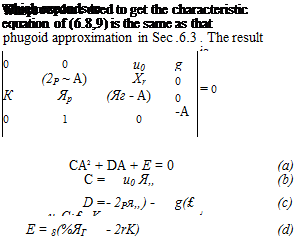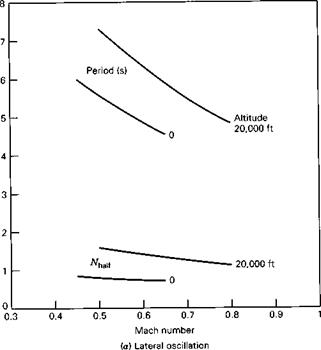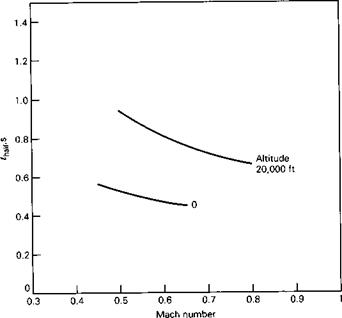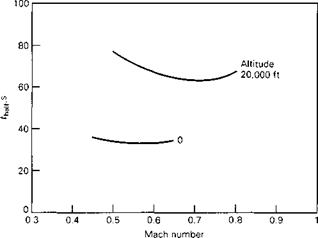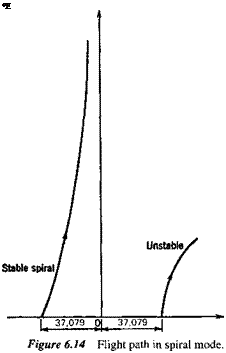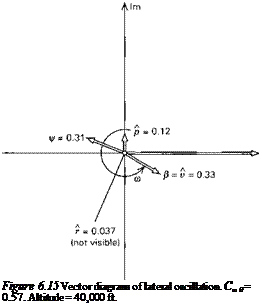In all the preceding examples, the atmosphere has been assumed to be at rest or to have a velocity uniform in space and constant in time. Since this is the exceptional rather than the usual case, it is necessary to examine the effects of nonuniform and unsteady motion of the atmosphere on the behavior of flight vehicles. The principal effects are those associated with atmospheric turbulence, and these are treated at some length in Etkin (1972, 1981). However, quite apart from turbulence, the wind
may have a mean structure which is not uniform in space, that is, there can be spatial gradients in the time-averaged velocity. The examples of most concern are down – bursts and the boundary layer next to the ground produced by the wind blowing over it. Downbursts are vertical outflows from low level clouds that impinge on the ground, somewhat in the manner of a circular jet, and spread horizontally. The resulting wind field has strong gradients, both horizontal and vertical. A number of airplane accidents have been attributed to this phenomenon.
In order to introduce wind into the analytical model, we must make any alterations that may be needed, because of the presence of the wind, to the aerodynamic forces and moments. In the trivial case when the wind is uniform and steady, no change is necessary to the representation of aerodynamic forces from that used before. However, turbulence and wind gradients may require such changes.
Since the linear model that was developed in Chap. 4 is based on small disturbances from a steady reference condition, and since there is no such steady state when the aircraft is landing or taking off through a boundary layer or downburst, the linear model is of limited use in these situations. For this kind of analysis, one must use the nonlinear equations (4.7,1)—(4.7,5) and introduce a model for the aerodynamic forces that embraces the whole range of speeds and attitudes that will occur throughout the transient (Etkin, B. and Etkin, D. A. (1990)). Such an analysis is beyond the scope of this volume.
There is one relevant steady state, however, that can be investigated with the linear model, and that is horizontal flight in the boundary layer. The planetary boundary layer has characteristics quite similar to the classical flat-plate turbulent boundary layer of aerodynamics. The vertical extent of this layer in strong winds depends mainly on the roughness of the underlying terrain, but is usually many hundreds of feet. Figure 6.17 shows the power-law profiles associated with different roughnesses. These are all of the form
W = khn
where, as indicated in the figure, h is height above the ground. The vertical gradient is then given by
For example, for smooth terrain (n = 0.16), and for a wind of 50 fps at 50 ft altitude, the gradient would be dW/dh = 0.16 fps/ft.
By way of example, we shall analyze what effect the vertical wind gradient has on the longitudinal modes of the STOL airplane of Sec. 6.6 in low speed flight, when wind effects can be expected to be largest. In order to generate the analytical model, we go back to the exact equations (4.7,1) et seq. The longitudinal equations, when linearized for small perturbations around a reference state of horizontal flight at speed u0 and в0 = 0 are
AX — mgQ = mAiib A Z = m(w’ — uEq) AM = Iyq 6=q
ZE = – иЬв + WE
|
Figure 6.17 Profiles of mean wind velocity over level terrains of differing roughness. (After A. G. Davenport, 1960)
|
The wind is specified to vary linearly with altitude with gradient Г = dW/dzE and to be parallel to the хг plane. The wind vector is prescribed in frame FE as
We will assume that this implies a tailwind of strength W0 at the reference height. For a wind that increases with altitude, Г = —sgn(W0)|r|. To convert WE to body axes, we use the transformation matrix L/JE [the transpose of (4.4,3)] for small angles and ф = ф = 0 to get (see Exercise 6.6)
|
" W0 + rzE "
|
|
” W0 + TzE
|
|
WB =
|
0
|
as
|
0
|
|
(W0 + TzE)e
|
|
w0e
|
In the third component of (6.9,5) we have neglected the second-order product zE6. We can now use (6.9,5) together with Vе = V + W to eliminate uE and wE from
(6.9,3) with the result
AX — mgO = m( Ай + TzF)
A Z = m(w + W06 — uEq)
AM = Iyq (6.9,6)
в=Ч
zE = ~ueQ + w + W06
We note that uE = u0 + W0 and eliminate 6 and zE from the right side of (6.9,6) with the result
AX — mg6 = т(Ай + Г[—и0в + w])
A Z = m(w — u0q)
AM = I# (6.9,7)
6=q
ZE = UqO + w
It is observed that the only explicit effect of wind on the system equations in this case is the term containing Г on the right side of the first equation. Since a uniform wind (i. e., Г = 0) does not affect the airplane dynamics the system must be independent of W0, and we see that W() does indeed not appear anywhere in the equations. In addition to what we see in (6.9,7), however, there are some implicit effects of the wind gradient on the aerodynamic derivatives.
It is clear that the changes in pressure distribution over the surfaces of a vehicle, and hence its basic aerodynamic derivatives, are not the same when the incident flow has a gradient Г as when it is spatially uniform. Two simple examples suffice to make this clear. (1) When there is a perturbation Да from the reference state, the tail moves downward into a region of lower air velocity and on this account one would expect CmJ to be smaller than normal. (2) When the wing rolls through an angle ф, the right tip moves into a low-wind region, and the left tip into a high-wind region. The gradient in velocity across the span is like that associated with yaw rate r, and hence we should expect values of С1ф and СПф proportional to the wing contributions to Clr and
C„r. Note that for upwind flight this leads to an unstable roll “stiffness” С! ф > 0 where none existed before (Ct is negative for downwind flight).
Reasonable estimates of the major changes in the basic derivatives associated with Г can be made from available aerodynamic theories, but a complete account of these is not currently available, and to develop them here would take us too far afield. Instead we simply incorporate the additional terms given by (6.9,7) into the longitudinal equations of motion and note the extent of the changes they make in the characteristic modes previously calculated. The appropriate matrix for this case is obtained from (4.9,18) by adding the two terms containing Г, and is given by (6.9,8).
(6.9,8)
In (6.9,8), A’ is the З X 4 matrix consisting of the last three rows of the matrix of
(4.9,18) , with 0O = 0.
An example of the results for the STOL airplane is shown in Figs. 6.18 and 6.19. The numerical data used was the same as in Sec. 6.6, with wind gradient variable from -0.30 fps/ft (the headwind case) to +0.30 fps/ft (the tailwind case). The effects on both the phugoid and pitching modes are seen to be large. A strong headwind decreases both the frequency and damping of the phugoid, and a strong tailwind changes the real pair of pitching roots into a complex pair representing a pitching oscillation of long period and heavy damping.
-0.5
-1.0
Figure 6.19 Effect of wind gradient on short-period roots—STOL airplane. Cw = 4.0.











 l S
l S